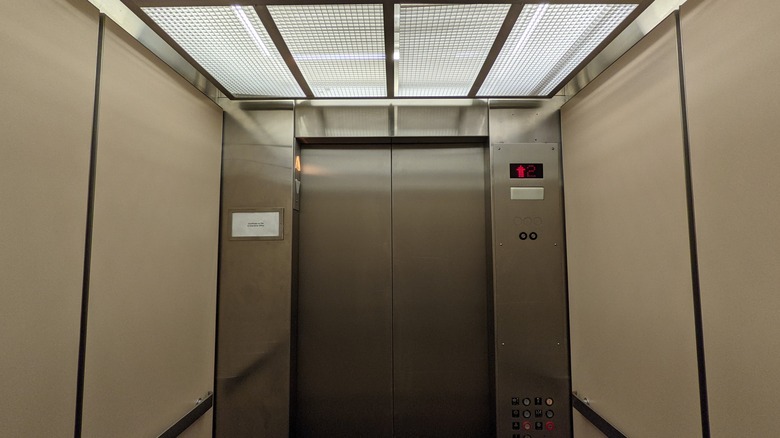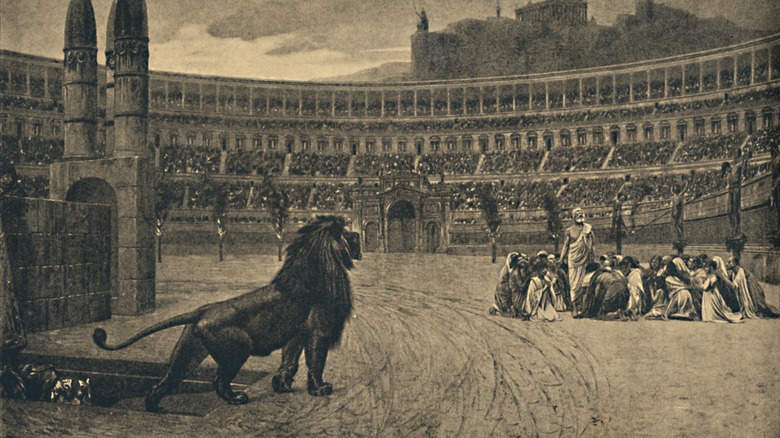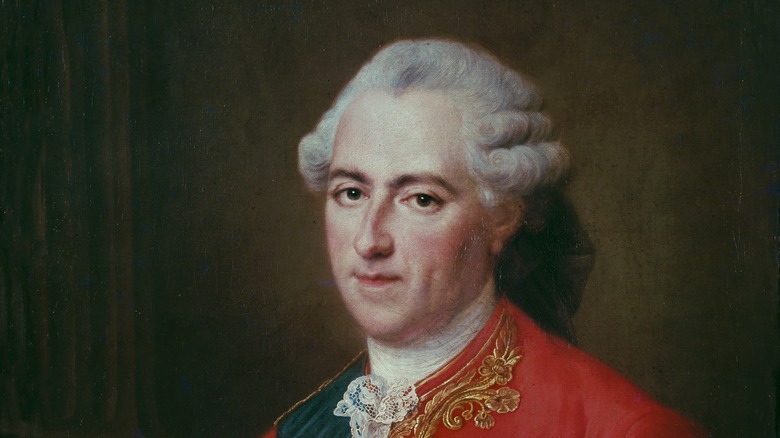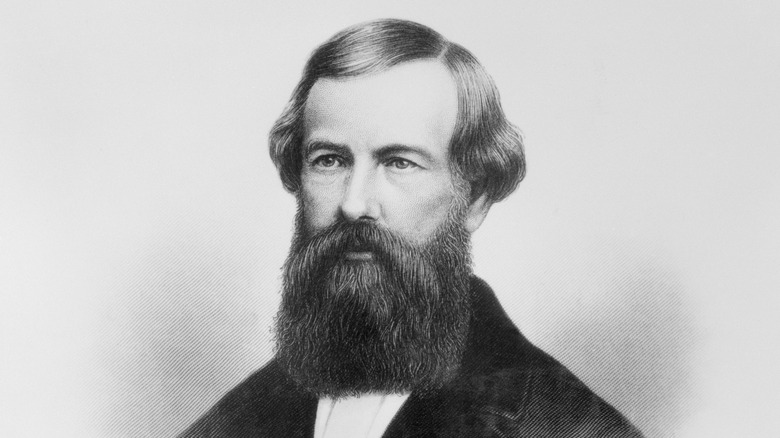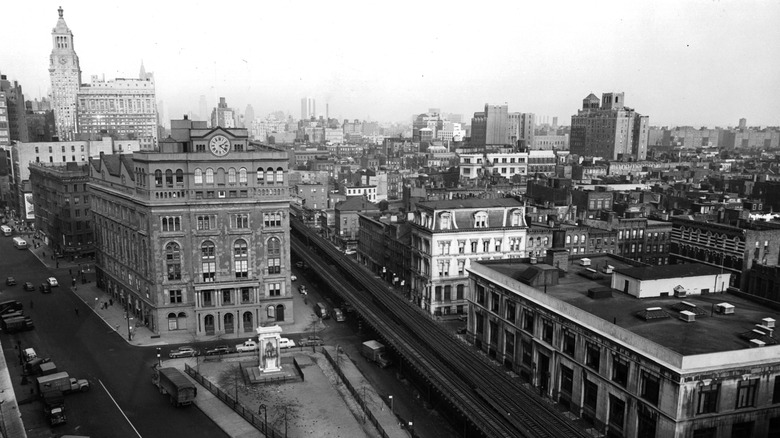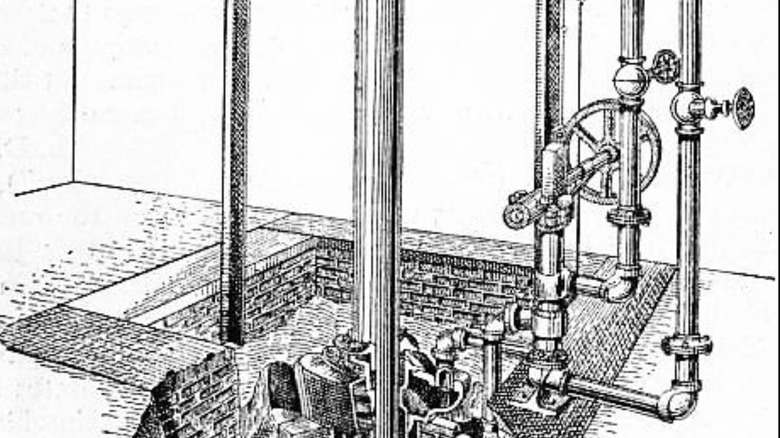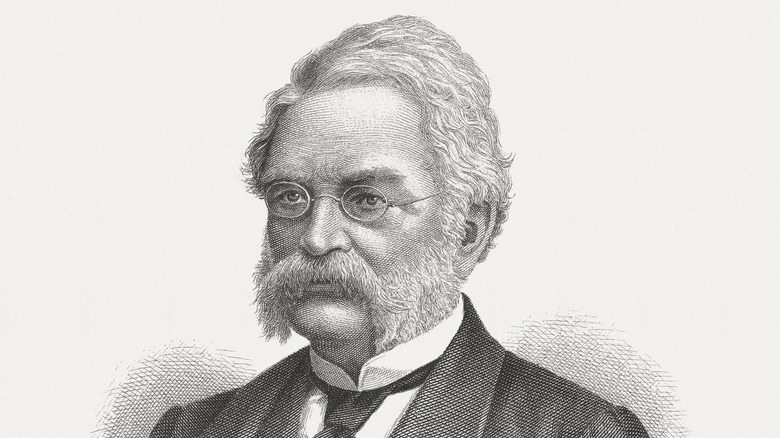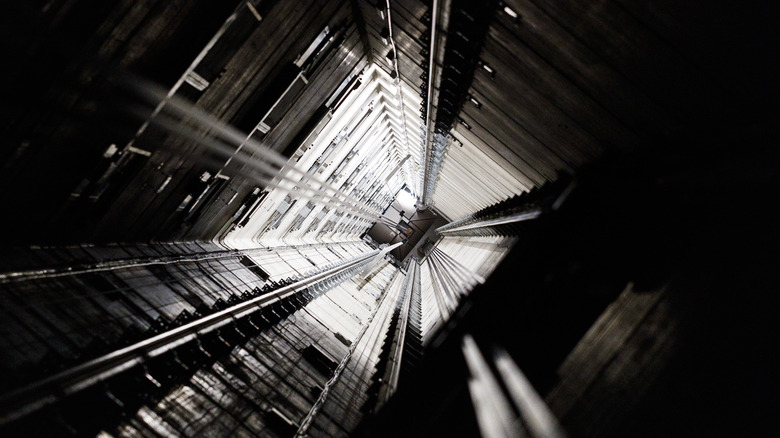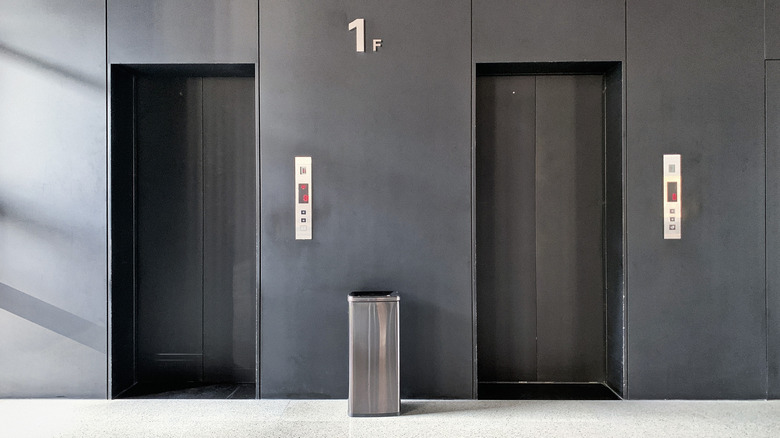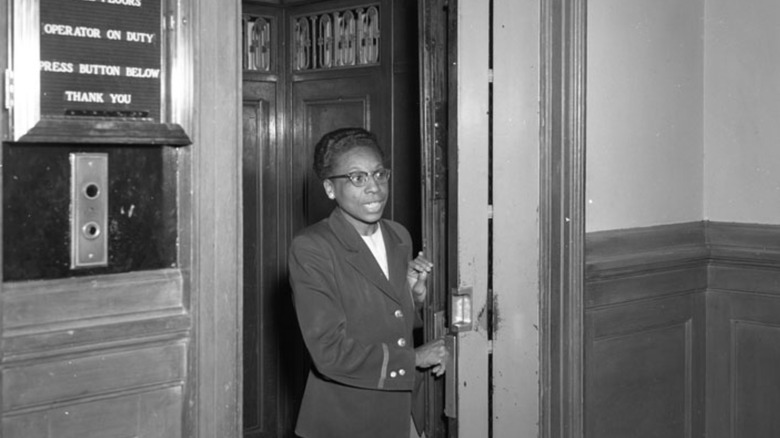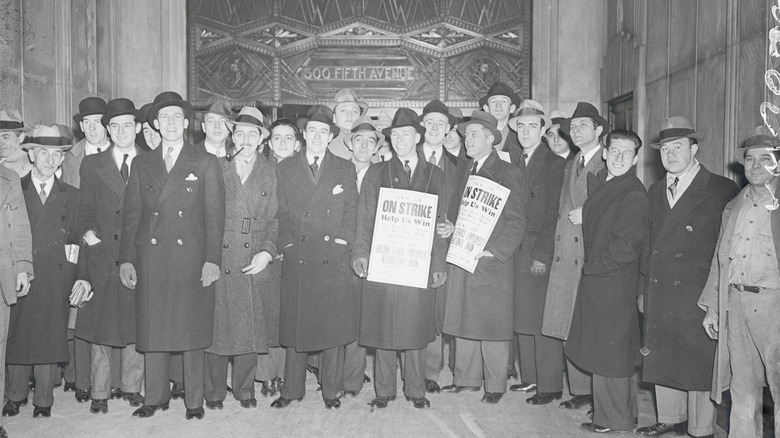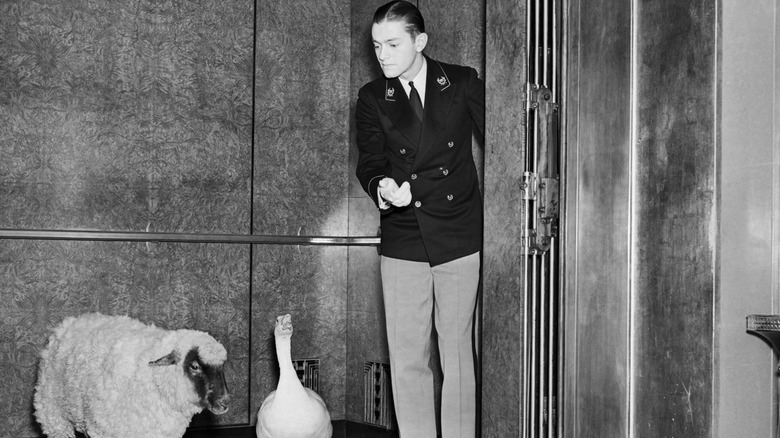The Untold History Of Elevators
Humans have always had a desire to go higher. But as buildings got taller and taller, it became more and more difficult for people to climb the endlessly increasing number of stairs. The elevator enabled people to climb upwards in a way that was never before possible. Without the elevator, many cities like Beijing, Dubai, and New York would look completely different. It also changed the demographics of where people lived in buildings: While the top floors used to be where people with lower incomes lived, once it became possible to coast up a building with ease, they swiftly became valued real estate. But before the modern elevator arrived, people throughout history were devising various ways to travel and lift things vertically.
However, the evolution of the elevator wasn't as smooth as most elevator rides today. Different propulsion methods were experimented with, and some people even suffered physical distress from early elevator rides. And widely ubiquitous jobs, like being an elevator operator, also came and went. Like an elevator itself, the history of the elevator is hardly static — here is the untold history of elevators.
[Featured image by Baron Maddock via Wikimedia Commons | Cropped and scaled | CC BY-SA 4.0]
The first elevators
Some of the earliest elevators are believed to have been invented in Ancient Greece and used ropes and pulleys to move things vertically. Based on the writings of Roman architect Vitruvius, it's believed that Greek mathematician Archimedes invented an elevator around 235 B.C.E. In Ancient Rome, elevators were also used to move caged animals onto the stage of the Roman Colosseum, with up to 30 lifts able to bear up to 600 pounds each. It's also been suggested that the palace of Emperor Nero had elevators working with pulleys and rope as well. But all of these elevators used muscle power to pull the load.
In the Middle Ages, another early form of an elevator, using wheels and a pulley, was used to lift people and equipment into monasteries with a large basket tied to rope. This was a commonly used method in the Middle Ages for both transporting supplies and constructing cathedrals. Even access to a wine cellar sometimes involved a similar type of elevator.
The flying chair
During his reign in the 18th century, King Louis XV of France needed a way to see his mistress Madame de Châteauroux, without her running into anyone on the way to or from his room. Louis XV's living quarters were right below his mistress's, and as a result, Blaise-Henri Arnoult installed what became known as a flying chair into the Palace of Versailles in 1743, Stefan Al writes in "Supertall."
Like the earlier elevators, which required other people to pull on the rope for the elevator to function, the flying chair was operated by servants for the king, and could take either Louis XV or Madame de Châteauroux up or down at a moment's notice from the king's balcony into a cabinet. It still operated using ropes and pulleys, but despite still being relatively simplistic, it's believed to be the first elevator with functioning doors.
And King Louis XV wasn't the only royal with an elevator in his home. According to "The Supermarket of the Visible" by Peter Szendy, similar elevators were also installed in several palaces, even before Louis XV installed his own.
Movable Rooms
During the early 19th century, the predominantly steam-powered elevators were manually operated via a relatively simple gear system known as a worm gear,and were mainly used for transporting equipment and supplies in factories or warehouses. Further innovations would broaden the elevator's appeal, such as The Otis Tufts Company's patented automatic steam valve. In conjunction with a steam-powered leather-belt drive, this allowed the elevator's position to determine how much steam was being used, rather than an operator. This reduced the chance of operator error — not uncommon with gear-driven elevators — and was thus safer.
After the emergency safety brake was added by inventor Elisha Graves Otis (pictured above), the first public passenger elevator became available in 1857, at New York City's Haughwout Store. Unfortunately, within three years of its invention, the elevator was abandoned since people thought it was too noisy, too slow, and they trusted the stairs more.
The elevator design was continually refined and, by 1860, another elevator was installed into a hotel on Fifth Avenue by inventor Otis Tufts. Because the elevator looked like a room with benches, the name movable room was coined to describe this new innovation for the public. But initially, the elevator was dismissively described by the New York Tribune to be mainly for women, claiming that "certainly a means to save women the debilitating labor of climbing up and down several flights of stairs will be appreciated," per "From Ascending Rooms to Express Elevators" by Lee Edward Grey.
The first elevator shaft
Although it sounds counterintuitive, the first passenger elevator shaft in the United States was constructed and built before the first passenger elevator was invented. When designing the Cooper Union Foundation building in 1853, American industrialist Peter Cooper included an elevator shaft in the designs, even though passenger elevators didn't exist. But Cooper thought that it wouldn't be long before one was invented, so he went with his hunch and constructed a building with an elevator shaft for a predicted future passenger elevator.
But Cooper was only half-right. Although the passenger elevator would be invented and installed into a building for the first time in 1857, Cooper's pre-made shaft wouldn't be the right shape for Elisha Graves Otis's elevator. Cooper had believed that a circular shape would be the most efficient and had constructed the shaft to be circular. This was indeed a real-life instance of needing to fit a square peg into a round hole, as Otis's elevators were rectangular.
The Cooper Union Foundation building got its round elevator eventually, but it never got a chance to match the first elevator shaft with the first passenger elevator.
Powered by water
Steam-powered elevators continued to be used until the 1870s, when hydraulic machines started to be used instead. But up until then, Elisha Graves Otis's steam-powered design was the standard for elevators and by the time the hydraulic elevator was invented, there were up to 2,000 Otis elevators across the world sold by the Otis Elevator Company, which was run by Otis's sons Charles R. and Norton P. Otis.
Hydraulic elevators work by using pressurized water or oil to push a piston, which in turn drives the elevator's motion. By 1880, the hydraulic elevator design was being used in both the United States and England, and when the Eiffel Tower opened in 1889, it used hydraulic elevators made by the Otis Elevator Company to bring visitors to the top of the tower. These hydraulic elevators were faster, smaller, and safer than their steam predecessors, and as buildings kept getting taller and taller, the design meant it was relatively easy to extend the distance that could be traveled by the elevator. But it still involved making the piston larger, which meant that the hole in the earth where the piston went also had to get bigger and bigger.
When the hydraulic elevator was invented by Cyrus W. Baldwin in 1870, he referred to it as a Hydro-Atmospheric Elevator. But before long, the elevator was known as the water balance elevator, due to the fact that the elevator used water and gravity to function.
The first electric elevator
As electrical power was discovered and harnessed in the second half of the 19th century, it didn't take long for elevators to benefit from this new energy source. The first electric elevator was invented in Germany by electrical engineer Werner von Siemens in 1880. Compared to the early Otis steam elevator, which moved at only half a mile per hour, von Siemens's electric elevator moved at an astonishing 1.1 miles per hour. Installed in Mannheim, Germany, from September to mid-November for the Mannheim Pfalzgau Trade & Agricultural Exhibition, the electric elevator carried over 8,000 people to a height of 65 feet, giving them a panoramic view of Mannheim.
In the United States, Frank Sprague separately created his own electric elevator in 1892 and after forming the Sprague Electric Elevator Company, he sold some of the first models of his electric elevator to the Postal Telegraph Company. However, Sprague claimed that the fastest his elevators could go was 7 miles per hour. Even though it was a marked difference from the early steam and hydraulic elevators, Sprague only sold up to 600 elevators worldwide before the Otis Elevator Company bought the Sprague Electric Elevator Company in 1895, according to Lemelson-MIT.
But the tides were starting to turn as more and more people were convinced by the potential of electric elevators. Before selling his company, one of Sprague's largest projects involved installing his electric elevators in the Central London Railway.
Elevator sickness
As elevators got faster, they didn't necessarily have the smoothest stopping ability, and by 1890, there was a new syndrome showing up amongst some Americans, known as elevator sickness. Whenever the elevator stopped after moving, some people in the elevator experienced intense dizziness and nausea, as reported by Scientific American in 1890, per "Future Angst" by Dr. Mario Herger. In 1890, Donahoe's Magazine reported: "the stoppage of the elevator car brings a dizziness to the head and sometimes a nausea at the stomach. The internal organs seem to want to rise into the throat." And according to Andreas Bernard's "Lifted : A Cultural History of the Elevator," a Chicago doctor claimed that elevator sickness caused "brain fever and disordered nervous systems."
It was determined that the discomfort was due to the fact that when stopping, the brakes wouldn't stop the entire body at the same time. This was unlike other types of motion sickness, which were associated with the motion itself rather than the fact that the elevators stopped suddenly. Some newspaper articles even recommended leaning one's upper body against the elevator to prevent elevator sickness.
Elevator music
Elevator music, often referred to as Muzak, was created by George Owen Squier in 1922. Muzak became the shorthand name to refer to the background music that would play within elevators. Often, they were instrumental versions of popular songs at the time. The music was specifically composed to not distract its passengers, and according to "Popular Music in Evangelical Youth Culture" by Stella Lau, this involved removing tempo changes, vocals, and loud brasses.
However, the technology that allowed for the transmission of Muzak wasn't originally invented for just music. In 1910, while serving in the Army, Squier developed a method of transmitting multiple lines of sound through telephone and powerlines, known as multiplexing. Realizing that this technology could be used to transmit music as well as telephone conversations, in the 1920s, Squier worked with North American Company to create Wired Radio, which used multiplexing to transmit music using power lines.
By 1934, Wired Music was renamed as Muzak and went into the business of creating background music for customer-facing businesses. WQXR writes that the music was sometimes referred to as potted palm music, because it came from speakers that were tucked behind large potted plants. At this time, Muzak was also incorporated into elevator rides. And according to "Next Big Thing" by Richard Faulk, the main motivation for including music was to calm people who were anxious about riding in an elevator, rather than actually attempting to create any particular ambiance.
Elevator operators
Although elevators that closed automatically were invented by Black American inventor Alexander Miles in 1887, an elevator operator was needed to control the movement of the elevator. By the 1940s, there were over 90,000 elevator operators across the United States.
Black men also sometimes worked as elevator operators, but because of segregation in some states, many Black people weren't allowed in their free time to ride on the elevators that they operated. But with the increase of immigration in the United States, some Black people who worked as elevator operators were fired and replaced by people who'd newly immigrated from Europe. During the Second World War, white women were also recruited to work as elevator operators after the male elevator operators left to join the service, and this was considered a patriotic duty, as LIFE Magazine wrote in 1943: "In a hotel, operating an elevator is a war job."
Working as an elevator operator didn't just involve transporting people to their necessary floor. Elevator operators were also expected to talk to people and reassure their fears about traveling in an elevator. Their appearance was also taken into consideration and, according to LIFE Magazine, some women were given classes on how to blend a powder base into their hairline to abide by the beauty standards of the time.
The elevator strikes
Between the 1920s and 1960s, elevator operators across the United States repeatedly went on strike for higher wages, shorter working hours, and overall better working conditions. One of the earliest strikes was in April 1920, when 17,000 elevator workers walked out of their jobs in New York City, with The New York Times reporting at the time that women were brought in to replace the striking men who had operated the elevators. Although the strike lasted just under a week, up to 5,000 elevator operators managed to negotiate new working contracts.
In New York City, elevator workers formed the union 32-B in April 1934, and according to the Bureau of Labor Statistics, by 1939 and in that year alone, there were up to 12 separate strikes by elevator workers across the country, with a combined total of over 6,700 workers striking. One of 32-B's largest victories came in 1945, when a six-day strike resulted in a 10-year peace agreement and anti-discrimination policy. Some 15,000 elevator operators went on strike, and because the people in New York's many buildings and skyscrapers depended on the elevators, the city was brought to a grinding halt. It's estimated that up to 1.5 million residents of New York City supported the strike by not crossing the picket line.
In 1956, Popular Science proposed the introduction of automatic elevator services to circumvent striking workers. And unfortunately for the elevator operators, rather than address their concerns, automation was eventually introduced into elevators.
No more elevator operators
By the 1960s, the technology for automatic elevators had existed for over 50 years. But the problem was that the public didn't trust the automation and, as a result, building owners wouldn't buy them, which prompted a public campaign to convince people that elevators without elevator operators were safe. Advertisements were aired that featured small children and older adults in the elevator, and automatic elevators were equipped with a voice that instructed the passenger to select their floor by pushing the corresponding button.
The introduction of fully automatic elevators was accomplished through this public campaign, but the desire to reassure people in the first place came mainly in response to the numerous strikes by elevator operators. One elevator-company official advocated for automatic elevators by stating that "they don't strike, get sick, flirt or go out for a smoke," per Popular Science. According to the 1966 Hearings before the United States Congress Joint Economic Committee, after a union of elevator workers in Chicago, Illinois, successfully negotiated a minimum wage of $2.50 an hour, building owners spent $30,000 per elevator to automate their elevators.
In 1950, the Otis Elevator Company installed the first completely automatic elevator in the Atlantic Refining Building in Dallas, Texas. Consequently, automatic elevators replaced elevator workers and became the only instance where automation has completely eliminated an occupation, at least for now.
